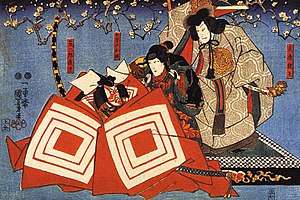Kumadori

The hero of Shibaraku, wearing kumadori makeup. Print by Utagawa Kuniyoshi.
| Part of a series on |
| Costume |
|---|
 |
|
Background
|
|
Society and culture |
|
Elements and methods |
|
Children |
|
Fictional |
|
Organizations |
|
People
|
|
Museums
|
Kumadori (隈取) is stage makeup worn by kabuki actors, particularly when performing in the bold and bombastic aragoto style. Kumadori makeup generally consists of brightly colored stripes or patterns over a white foundation, the colors and patterns symbolizing aspects of the actor's character. Though kumadori was originated and developed extensively by members of the Ichikawa Danjūrō line of actors, some conventions are creations of the Onoe Kikugorō line.
- Bright red stripes indicate a powerful hero role. The most famous of these roles, and the one which has come to stereotypically represent kabuki in the West, is the hero of Shibaraku. Red symbolizes virtue and power.
- Villains are often depicted with a design of black beard, purple veins, and dark blue antler-like eyebrows.
- Blue makeup can represent a ghost, spirit, or other magical creature, depending on the patterns. Kitsune such as Genkurō in Yoshitsune Senbon Zakura wear blue makeup. Blue represents negative emotions such as jealousy or fear; ghosts in traditional Japanese drama are often trapped by their attachment to such emotions.[1]
- Greys and browns can be used sometimes, particularly when representing animals, oni (demons), yōkai (monsters), or anything else inhuman. One example is the tsuchigumo (ground spider) fought by Minamoto no Raikō.
The term also applies to a painting method in which two brushes are used simultaneously, one for the color and the other used to create shading or other details.
An impression of a kabuki actor's face make-up, preserved on a piece of cloth, is known as an oshiguma.
Sources
- Ronald Cavaye: A Guide to the Japanese Stage – From Traditional to Cutting Edge, Kodansha,Tokyo, 2005 ISBN 978-4-77002987-4
References
- ↑ "Some FAQ About Kumadori Makeup". Retrieved 2017-07-08.
- Kumadori at Kabuki-Jiten (Japanese)
- Kincaid, Zoe (1925). Kabuki: The Popular Stage of Japan. London: MacMillan and Co.
External links
| Wikimedia Commons has media related to Kumadori. |
This article is issued from
Wikipedia.
The text is licensed under Creative Commons - Attribution - Sharealike.
Additional terms may apply for the media files.